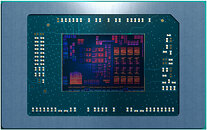- Joined
- Oct 9, 2007
- Messages
- 47,528 (7.48/day)
- Location
- Hyderabad, India
| System Name | RBMK-1000 |
|---|---|
| Processor | AMD Ryzen 7 5700G |
| Motherboard | ASUS ROG Strix B450-E Gaming |
| Cooling | DeepCool Gammax L240 V2 |
| Memory | 2x 8GB G.Skill Sniper X |
| Video Card(s) | Palit GeForce RTX 2080 SUPER GameRock |
| Storage | Western Digital Black NVMe 512GB |
| Display(s) | BenQ 1440p 60 Hz 27-inch |
| Case | Corsair Carbide 100R |
| Audio Device(s) | ASUS SupremeFX S1220A |
| Power Supply | Cooler Master MWE Gold 650W |
| Mouse | ASUS ROG Strix Impact |
| Keyboard | Gamdias Hermes E2 |
| Software | Windows 11 Pro |
The online datasheets of some of the first AMD Ryzen 7040 series "Phoenix Point" mobile processors went live, detailing the processor's I/O feature-set. We learn that AMD has decided to give PCI-Express Gen 5 a skip with this silicon, at least in its mobile avatar. The Ryzen 7040 SoC puts out a total of 20 PCI-Express Gen 4 lanes, all of which are "usable" (i.e. don't count 4 lanes toward chipset-bus). This would mean that the silicon has a full PCI-Express 4.0 x16 interface for discrete graphics, and a PCI-Express 4.0 x4 link for a CPU-attached M.2 NVMe slot; unlike the "Raphael" desktop MCM and the "Dragon Range" mobile MCM, whose client I/O dies put out a total of 28 Gen 5 lanes (24 usable, with x16 PEG + two x4 toward CPU-attached M.2 slots).
Another interesting aspect about "Phoenix Point" is its memory controllers. The SoC features a dual-channel (four sub-channel) DDR5 memory interface, besides support for LPDDR5 and LPDDR5x. DDR5-5600 and LPDDR5-7600 are the native speeds supported. What's really interesting is the maximum amount of memory supported, which stands at 256 GB—double that of "Raphael" and "Dragon Range," which top out at 128 GB. This bodes well for the eventual Socket AM5 APUs AMD will design based on the "Phoenix Point" silicon. Older Ryzen 5000G "Cezanne" desktop APUs are known for superior memory overclocking capabilities to 5000X "Vermeer," with the monolithic nature of the silicon favoring latencies. Something similar could be expected from "Phoenix Point."




The iGPU of the Ryzen 7040 series in its top avatar will have the branding "Radeon 780M," an upgrade from the "Radeon 680M" of the top iGPU option available with the "Rembrandt" silicon and its RDNA2-based iGPU. The new 780M is based on the latest RDNA3 graphics architecture, and packs 12 compute units (768 stream processors), with the same dual-instruction issue rate capabilities as the desktop Radeon RX 7900 series GPUs; and matrix-math accelerators (these are besides the dedicated XDNA AI accelerator present on the "Phoenix Point" silicon). The iGPU has engine clocks as high as 2.90 GHz.
The iGPU of "Phoenix Point" is confirmed to feature AMD's latest Radiance Display Engine, with support for DisplayPort 2.1 UHBR10 and HDMI 2.1, with native support for 8K 60 Hz displays with a single cable. It also features the latest VCN media engine, with hardware-accelerated AV1 encoding up to 4K @ 240 Hz 10 bpc, and 4320p @ 175 Hz 8 bpc H.265; and hardware-accelerated decoding of nearly all standard resolutions/bit-depth/framerates of MPEG2, VC1, VP9, H.264, H.265, and AV1.

Built on the 4 nm EUV foundry node at TSMC, the "Phoenix Point" monolithic silicon has a die-area of 178 mm², and a transistor-count of 25 billion. Besides the iGPU, it features a single 8-core "Zen 4" CCX. Each of the 8 CPU cores has 1 MB of dedicated L2 cache, and share 32 MB of L3 cache.
Many Thanks to TumbleGeorge for the tip!
View at TechPowerUp Main Site | Source
Another interesting aspect about "Phoenix Point" is its memory controllers. The SoC features a dual-channel (four sub-channel) DDR5 memory interface, besides support for LPDDR5 and LPDDR5x. DDR5-5600 and LPDDR5-7600 are the native speeds supported. What's really interesting is the maximum amount of memory supported, which stands at 256 GB—double that of "Raphael" and "Dragon Range," which top out at 128 GB. This bodes well for the eventual Socket AM5 APUs AMD will design based on the "Phoenix Point" silicon. Older Ryzen 5000G "Cezanne" desktop APUs are known for superior memory overclocking capabilities to 5000X "Vermeer," with the monolithic nature of the silicon favoring latencies. Something similar could be expected from "Phoenix Point."




The iGPU of the Ryzen 7040 series in its top avatar will have the branding "Radeon 780M," an upgrade from the "Radeon 680M" of the top iGPU option available with the "Rembrandt" silicon and its RDNA2-based iGPU. The new 780M is based on the latest RDNA3 graphics architecture, and packs 12 compute units (768 stream processors), with the same dual-instruction issue rate capabilities as the desktop Radeon RX 7900 series GPUs; and matrix-math accelerators (these are besides the dedicated XDNA AI accelerator present on the "Phoenix Point" silicon). The iGPU has engine clocks as high as 2.90 GHz.
The iGPU of "Phoenix Point" is confirmed to feature AMD's latest Radiance Display Engine, with support for DisplayPort 2.1 UHBR10 and HDMI 2.1, with native support for 8K 60 Hz displays with a single cable. It also features the latest VCN media engine, with hardware-accelerated AV1 encoding up to 4K @ 240 Hz 10 bpc, and 4320p @ 175 Hz 8 bpc H.265; and hardware-accelerated decoding of nearly all standard resolutions/bit-depth/framerates of MPEG2, VC1, VP9, H.264, H.265, and AV1.

Built on the 4 nm EUV foundry node at TSMC, the "Phoenix Point" monolithic silicon has a die-area of 178 mm², and a transistor-count of 25 billion. Besides the iGPU, it features a single 8-core "Zen 4" CCX. Each of the 8 CPU cores has 1 MB of dedicated L2 cache, and share 32 MB of L3 cache.
Many Thanks to TumbleGeorge for the tip!
View at TechPowerUp Main Site | Source




